Related Research Articles

Saccharum is a genus of tall perennial plants of the broomsedge tribe within the grass family.
In botany and agriculture, stunting describes a plant disease that results in dwarfing and loss of vigor. It may be caused by infectious or noninfectious means.
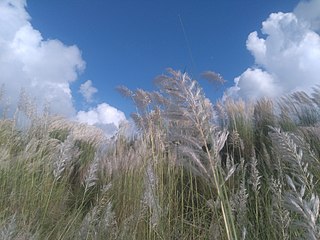
Saccharum spontaneum is a grass native to the Indian Subcontinent. It is a perennial grass, growing up to three meters in height, with spreading rhizomatous roots.
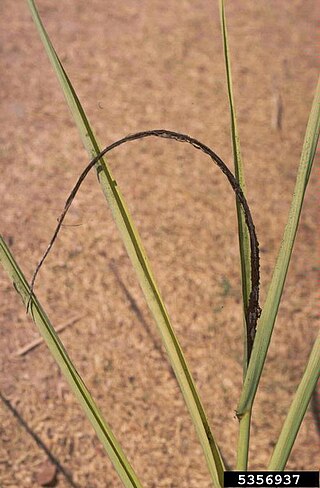
Sugarcane smut is a fungal disease of sugarcane caused by the fungus Sporisorium scitamineum. The disease is known as culmicolous, which describes the outgrowth of fungus of the stalk on the cane. It attacks several sugarcane species and has been reported to occur on a few other grass species as well, but not to a critical amount. The most recognizable characteristic of this disease is a black or gray growth that is referred to as a "smut whip". Resistance to sugarcane smut is the best course of action for management, but also the use of disease free seed is important. On smaller scale operations treatments using hot water and removing infected plants can be effective. The main mode of spore dispersal is the wind but the disease also spreads through the use of infected cuttings. Sugarcane smut is a devastating disease in sugarcane growing areas globally.

Leptosphaeria sacchari is a plant pathogenic fungus which causes a disease called ring spot on Saccharum officinarum. This species was originally described in 1890 by Kruger and in 1892 by Van Breda de Haan after it was discovered in the Dominican Republic. L. sacchari is the applied name, whereas Epicoccum sorghinum is the accepted name.

Puccinia melanocephala is a plant pathogen, it is the causal agent of sugarcane rust. This pathogen affects multiple species of sugarcane, including Saccharum spontaneum or wild sugarcane, Saccharum robustum, and the most commonly cultivated species Saccharum officinarum. Puccinia melanocephala can also infect other member of the family Poaceae, including some species of bamboo such as Bambusa vulgaris. The first symptoms of sugarcane rust are elongate, yellow-colored leaf spots, roughly 1mm to 4mm in length. The leaf spots gradually become bigger and turn a reddish-brown color. The uredia develop underneath the epidermis where the leaf spots are present. When the uredia become big enough, they break through the epidermis to form the characteristic rust pustules from which uredospores are borne. These pustules can coalesce, resulting in large areas of dead tissue.

Sugarcane or sugar cane is a species of tall, perennial grass that is used for sugar production. The plants are 2–6 m (6–20 ft) tall with stout, jointed, fibrous stalks that are rich in sucrose, which accumulates in the stalk internodes. Sugarcanes belong to the grass family, Poaceae, an economically important flowering plant family that includes maize, wheat, rice, and sorghum, and many forage crops. It is native to the warm temperate and tropical regions of India, Southeast Asia, and New Guinea. The plant is also grown for biofuel production, especially in Brazil, as the canes can be used directly to produce ethyl alcohol (ethanol).

Sugar was first produced from sugarcane plants in India sometime after the first century AD. The derivation of the word "sugar" is thought to be from Sanskrit शर्करा (śarkarā), meaning "ground or candied sugar," originally "grit, gravel". Sanskrit literature from ancient India, written between 1500 - 500 BC provides the first documentation of the cultivation of sugar cane and of the manufacture of sugar in the Bengal region of the Indian subcontinent.

New Guinea is the world's second-largest island with an area of 785,753 km2 (303,381 sq mi). Located in Oceania in the southwestern Pacific Ocean, the island is separated from Australia by the 150-kilometre wide Torres Strait, though both landmasses lie on the same continental shelf. Numerous smaller islands are located to the west and east. The eastern half of the island is the major land mass of the independent state of Papua New Guinea. The western half, known as Western New Guinea, forms a part of Indonesia and is organized as the provinces of Papua, Central Papua, Highland Papua, South Papua, Southwest Papua, and West Papua. The largest cities on the island are Jayapura and Port Moresby.

Sugarcane grassy shoot disease (SCGS), is associated with ‘Candidatus Phytoplasma sacchari’ which are small, pleomorphic, pathogenic bacteria that contributes to yield losses from 5% up to 20% in sugarcane. These losses are higher in the ratoon crop. A higher incidence of SCGS has been recorded in some parts of Southeast Asia and India, resulting in 100% loss in cane yield and sugar production.
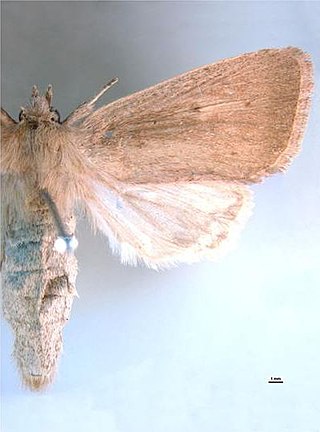
Sesamia grisescens, the pink sugarcane borer, pink stalk borer, shoot borer, sugarcane borer or ramu shoot borer, is a moth of the family Noctuidae. The species was first described by Warren in 1911. It is found in Papua New Guinea, Seram, the Moluccas and New Britain.
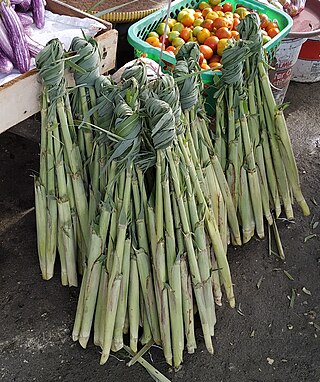
Saccharum edule is a species of sugarcane, that is a grass in the genus Saccharum with a fibrous stalk that is rich in sugar. It is cultivated in tropical climates in southeastern Asia. It has many common names which include duruka, tebu telor, Fiji asparagus, dule (Fiji), pitpit (Melanesia) and naviso.
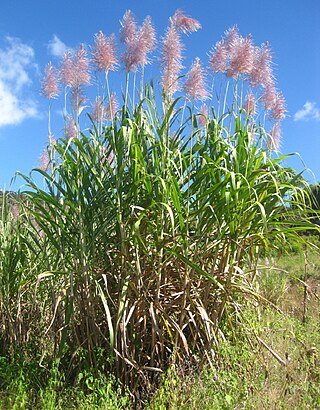
Saccharum officinarum is a large, strong-growing species of grass in the genus Saccharum. Its stout stalks are rich in sucrose, a simple sugar which accumulates in the stalk internodes. It originated in New Guinea, and is now cultivated in tropical and subtropical countries worldwide for the production of sugar, ethanol and other products.
Scirpophaga excerptalis, the white top borer or sugarcane top borer, is a moth in the family Crambidae. It was described by Francis Walker in 1863. It is found in southern Asia from the Indian Subcontinent in the west to southern China in the east, south to New Guinea, possibly Australia and the Solomon Islands.

Charles Alfred Barber C.I.E. was a British botanist and specialist on sugarcane, who worked for much of his life in southern India. Saccharum barberi, a species of sugarcane that grows wild in northern India is named after him. He was a pioneer in the nobilization of wild canes in India, by producing hybrids between wild and hardy local species and the high-sugar-yielding cultivated Saccharum officinarum that could survive the cold winters of northern India.
The Ramu stunt disease is a disease of the sugarcane widespread throughout Papua New Guinea, but not detected in Australia. Eumetopina flavipes, the island sugarcane planthopper, is a species of planthopper present throughout South East Asia which is a vector for the disease.
Saccharum robustum, the robust cane, is a species of plant found in New Guinea.
Rao BahadurSir Tiruvadi Sambasiva Iyer Venkataraman CIE, FNI, FASc was an Indian botanist, agronomist and plant geneticist who specialised in the study and hybridisation of sugarcane. He developed or supervised the development of numerous high-yield sugarcane cultivars, which established India as the world's second largest sugar producer and sustained the sugar industries of numerous other nations, including South Africa, Australia, Bangladesh, Indonesia, Pakistan, and the United States.

Saccharum sinense or Saccharum × sinense, synonym Saccharum × barberi, sugarcane, is strong-growing species of grass (Poaceae) in the genus Saccharum. It is originally cultivated in Guangzhou, China where it is still commonly grown. It is a more primitive form of sugarcane with a hybrid origin from wild species of cane. A number of clones exists that are often included in the S. officinarum species as the Pansahi group. The most notable member of which is the Uba variety of cane. They are a perennial plant that grows in erect clumps that can reach up to 5 meters in height and have a red cane with a diameter of 15 mm to 30 mm.